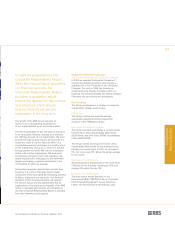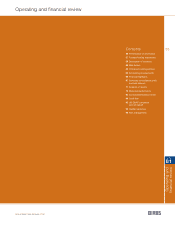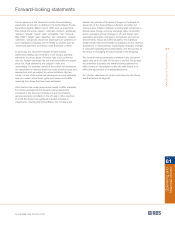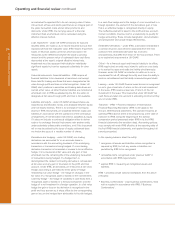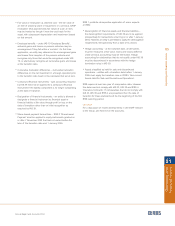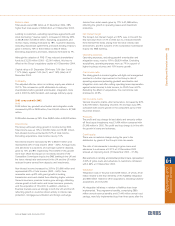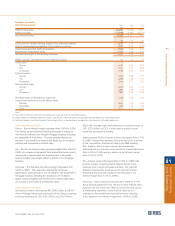RBS 2004 Annual Report Download - page 63
Download and view the complete annual report
Please find page 63 of the 2004 RBS annual report below. You can navigate through the pages in the report by either clicking on the pages listed below, or by using the keyword search tool below to find specific information within the annual report.
section
01
Operating and
financial review
61
Annual Report and Accounts 2004
Operating and financial review
Provisions for bad and doubtful debts
The Group provides for losses existing in its lending book so
as to state its loan portfolio at its expected ultimate net
realisable value. Specific provisions are established against
individual exposures and the general provision covers
advances impaired at the balance sheet date but which have
not been identified as such. Bad and doubtful debt provisions
made during the year less amounts released and recoveries of
amounts written-off in previous years are charged to the profit
and loss account. Loans and advances are reported on the
balance sheet net of specific and general provisions.
For certain homogeneous portfolios, including credit card
receivables and other personal advances including mortgages,
specific provisions are established on a portfolio basis, taking
into account the level of arrears, security, past loss experience,
credit scores and defaults based on portfolio trends. The most
significant factors in establishing these provisions are the
expected loss rates and the related average life. These factors
are kept under constant review by the Group.
Other loans and advances are individually assessed and the
specific provision is determined from a review of the financial
condition of the borrower and any guarantor and takes into
account the customer’s debt capacity and financial flexibility;
the level and quality of earnings; the amount and sources of
cash flows; the industry in which the customer operates; and
the realisable value of any security held. The most significant
estimates that affect the quantum of a specific provision are
the receipts from the borrower and the amount that will be
recovered from any security held.
Evaluating these estimates involves significant judgement as
receipts will depend on the future performance of the borrower
and the value of security, both of which will be affected by
future economic conditions. Additionally, the security may not
be readily marketable.
The general provision covers bad and doubtful debts that have
not been separately identified at the balance sheet date but
are known to be present in any portfolio of advances. The level
of general provision is assessed in the light of past experience
and reflects the size and diversity of the Group’s loan portfolio,
the current state of the economies in which the Group operates,
other factors affecting the business environment, recent trends
in companies going into administration, receivership and
bankruptcy and the Group’s monitoring and control procedures,
including the scope of specific provisioning procedures.
The future credit quality of the Group’s lending book is subject
to uncertainties that could cause actual credit losses to differ
materially from reported loan loss provisions. These
uncertainties include the economic environment, notably
interest rates and their effect on customer spending, the
unemployment level, payment behaviour and bankruptcy trends
and changes in the Group’s portfolios.
Loans and advances – recognition of interest income
Interest receivable from loans and advances is credited to the
profit and loss account as it accrues unless there is significant
doubt that it can be collected. If the collection of interest is in
doubt, it is credited to a suspense account and excluded from
interest receivable; it continues to be charged to the
customer’s account.
Pensions
The Group operates a number of defined benefit pension
schemes as described in Note 3 on the financial statements.
The assets of the schemes are measured at their fair value at
the balance sheet date. Scheme liabilities are measured using
the projected unit method, which takes account of projected
earnings increases, using actuarial assumptions that give the
best estimate of the future cash flows that will arise under the
scheme liabilities. These cash flows are discounted at the
interest rate applicable to high-quality corporate bonds of the
same currency and term as the liabilities. Any surplus or deficit
of scheme assets over liabilities is recognised in the balance
sheet as an asset (surplus) or liability (deficit). An asset is only
recognised to the extent that the surplus can be recovered
through reduced contributions in the future or through refunds
from the scheme. In determining the value of scheme liabilities
assumptions are made as to price inflation, dividend growth,
pension increases, earnings growth and employees. There is a
range of assumptions that could be adopted in valuing the
schemes' liabilities. Different assumptions could significantly
alter the amount of the deficit recognised in the balance sheet
and the pension cost charged to the profit and loss account.
The assumptions underlying the 2004 deficit and pension cost
are set out in Note 3 on the financial statements.
Fair value
Securities and derivatives held for trading purposes are
recognised in the financial statements at fair value. In the
balance sheet, trading securities are included within Treasury
and other eligible bills, Debt securities and Equity shares as
appropriate. Positive fair values (assets) of trading derivatives
are included in Other assets and negative fair values (liabilities)
in Other liabilities. Positive and negative fair values of trading
derivatives are offset where the contracts have been entered
into under master netting agreements or other agreements that
give a legally enforceable right of set-off. Gains or losses
arising from changes in fair value are included in Dealing
profits in the profit and loss account.
Fair value is the value at which a position could be closed out
or sold in a transaction to a willing and knowledgeable
counterparty over a reasonable period of time under current
market conditions. Fair values are determined by reference to
observable market prices where available and reliable. Where
representative market prices for an instrument are not available
or are unreliable because of poor liquidity, the fair value is
derived from prices for its components using appropriate
pricing or valuation models that are based on independently
sourced market parameters, including interest rate yield
curves, option volatilities and currency rates.


